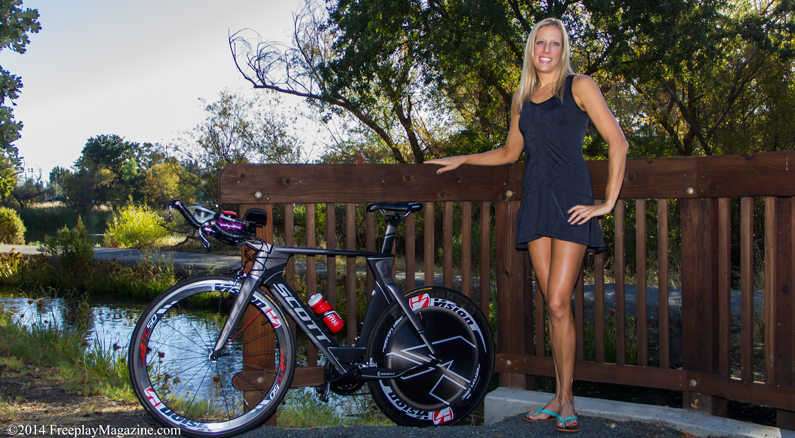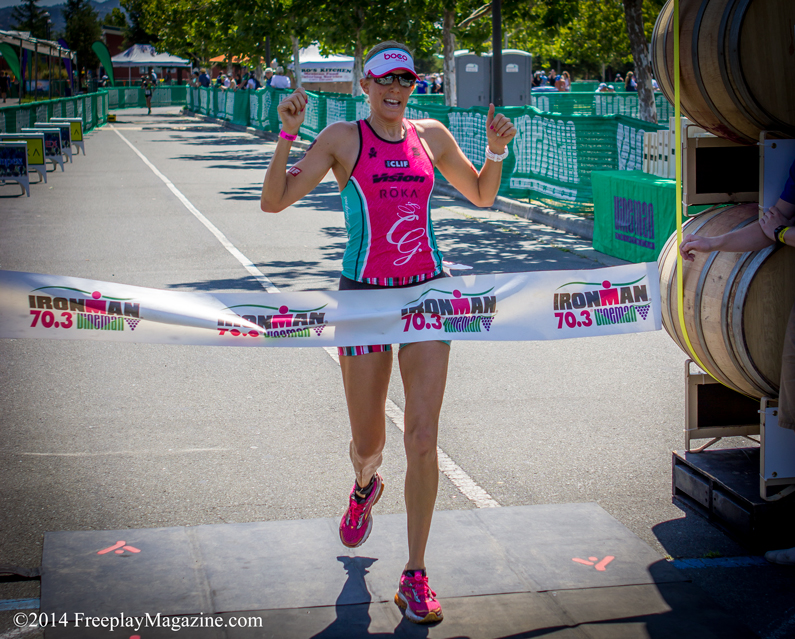
After battling injuries in 2013, Caroline Gregory made her return to Ironman competition this past spring at Ironman Los Cabos. After successfully completing the 140.6 mile race Gregory knew that she was healthy enough to continue to pursue her goals in the sport. Recently Gregory placed 11th in the professional field at Vineman 70.3 in a time of 4:36:53. We caught up with Gregory to hear more about her rehab, training and goals for the rest of the season.
Congratulations on a great race at Vineman 70.3 last weekend. Coming off some foot injuries at the end of last year you are probably happy to not only be running again but to put together a solid run(1:27) off the bike in Windsor. How has your run training progressed from taking time off to heal to getting back in race shape?
Thanks so much! Yes, having an injury is one thing, but battling through an injury without answers, for as long as I did is another. I really thought IM Louisville last year would be my last. After giving myself significant time off I was determined to keep searching for answers and trying new things. I was incredibly open to a new approach to treatment. This season I’ve been blessed to find a tremendous team to help me battle back. I can’t say enough about my rehab team of Curtis Cramblett and Chis Daprato. By taking a full body approach this dynamic duo FINALLY got to the root of my problem (which had little to do with my feet).
I also knew that after years of intense pain I had to address what this injury did to my mental state. I started working with Tim Snow of QT2 Systems and together we’ve slowly pulled me back to a point where I believe in myself again. Continuing with the theme of trying new things, I met Lucy Yaldezian of A Higher Perspective. She’s introduced me to a magnitude of mental exercises, including hypnosis, to help me work through the mental side of training and racing. Slowly we were able to change my mental association with running and pain, and especially with racing and pain.
My run at Vineman was as much of a mental boost as it was physical. It’s been a long road back, but I’m finally back to 100% of my training run volume. It’s starting to show, and I am incredibly happy and thankfully to the running form and speed I once knew.
Early this season you raced Ironman Los Cabos. Although it was not quite the race you were hoping for you were out there racing an Ironman again. Did you change anything in your training between the Ironman and Vineman?
The goal going into Ironman Los Cabos was proving to myself that I could race Ironman again. We were incredibly cautious going into Cabo in terms of training volume and intensity. If it were up to me I would of started track workouts and high volume running in order to get ready for Cabo. God bless Tim’s patience with me as he held me back and reminded me (almost weekly) that we couldn’t come back too soon. Cabo gave us the green light to keep at it…to continue towards our long term goals.
Immediately I started working on building strength and durability. I got back in the gym for a phase of max lifting. This lead to some less than desirable racing at Wildflower and Alcatraz, but is essential for Iong-term Ironman racing. My next race will be Ironman Louisville, so all of my racing between Los Cabos and Louisville are secondary. Vineman happened to fall at the end of a training block that involved a bit more speed work. It’s hard not to constantly see immediate results, but Tim constantly reminds me to believe in the process. It’s great to finally see things clicking.
Do you have another Ironmans on your schedule this year or are you going to use your momentum from Vineman and continue to race 70.3 this year?
Yes. I plan to race Ironman Louisville next month. I walked away from that course last year with a very heavy heart. The volunteers, spectators and other racers pulled me through what was one of my toughest races to date. Louisville provides an amazing atmosphere for Ironman and I can’t wait to return this year under much different circumstances. Vineman definitely gives me the motivation and mental boost to make it through my last big training block.
When we talked with you last year you were juggling working full time and training [ Freeplay Volume 2 | Issue 6 ]. Is this still the case? If so any tips for other aspiring elite triathletes who are also busy working full time?
Absolutely. Sadly the money in triathlon isn’t enough to live on, and I’m not willing to walk away from the career I worked so hard to build.
I have been at Accela for over two years. It is a very exciting time to be part of this growing company, and has been a welcomed change from my days as a litigation attorney. I am fortunate to work with tremendous people who are equally motivated to win.
While I won’t sacrifice my working career, I do sacrifice a lot to compete at this level. The biggest difference between professional triathletes and age groupers isn’t necessarily the volume of training, but the ability to recover properly. I utilize 110% Play Harder products to help me recover instantly after training. I put my compression tights, with ice, on after my morning training to help accelerate my recovery. Instead of meeting up with friends or going out to dinner after work or on the weekends I spend any free time foam rolling, relaxing my NormaTec boots, doing at home rehab and sleeping. I also pay tremendous attention to nutrition. I use recovery shakes immediately after my most intense workout each day (I use to skip these because I didn’t want the added calories and preferred real food only). The principles of the Core Diet have provided that added element to make sure my daily nutrition is in check with my current training cycle and volume.
Now that you are healthy again and racing strong is there anything you learned from your last injury that you can share with us or anything you are doing different this season?
I don’t even know where to start to be honest. I really made a lot of changes this year, but ultimately it came down to refusing to give up. I had one (highly revered) doctor telling me I needed to have (perfectly healthy and unfractured) bones surgically removed from my foot to help eliminate the pain. This sounded absolutely ridiculous to me, and I am thankful that I didn’t agree to such a measure out of desperation.
Instead it took finding practitioners who looked at my entire body as an intertwined working unit. Curtis (Cramblett – http://www.revolutionsinfitness.com ) worked on releasing the muscles around my rib cage and bike fit, while Chris (Daprato) worked on releasing my calfs with myofascial decompression technique (aka: cupping: www.cuptherapy.com) and reprogramming proper run form, and Lucy Yaldezian (http://www.ahigherperspective.com) helped me change the strong mental pathway/ connection between my foot pain and mind. It really has taken a village to get me back to racing healthy again, once again reminding me that “it’s all about the journey!”








